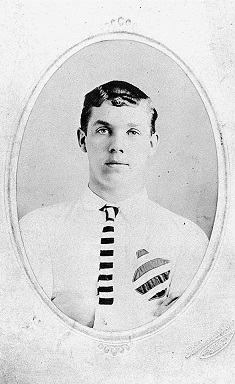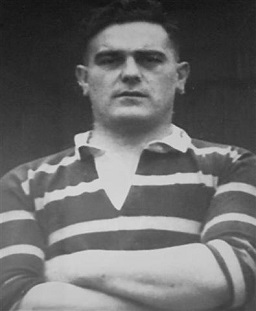Related Research Articles

Percival Thomas Harris, also known by the nickname of "Bomber", was a Welsh rugby union and World Cup winning professional rugby league footballer who played in the 1950s and 1960s, and coached rugby league in the 1960s and 1970s. He played club level rugby union (RU) for Newbridge RFC, as a hooker, and representative rugby league (RL) for Great Britain winning the 1960 Rugby League World Cup and Wales, and at club level for Hull F.C. winning the 1960 Lance Todd Trophy, as a hooker, he remained at Hull F.C. for his entire playing career, ultimately becoming an inductee in the club's Hall of Fame, he also set the record for most test matches played for Great Britain of any hooker, and coached at club level for York.

Jonathan "Jonty" Parkin (1894–1972) was an English professional rugby league footballer who played the 1910s, 1920s and 1930s. One of the nine inaugural inductees of the Rugby Football League Hall of Fame, he toured Australia three times, twice as captain of Great Britain, earning 17 Test caps. Parkin played at stand-off or scrum-half, and also captained England for whom he made 12 appearances, as well as 17 for Yorkshire. Parkin gave the Wakefield Trinity club seventeen years' service, including victory in the 1924–25 Yorkshire Cup.
The 1959–60 Rugby Football League season was the 65th season of rugby league football played in England. The championship, which involved thirty teams, started in August 1959 and culminated in a finals play-off series in May 1960 which resulted in a championship final between Wigan and Wakefield Trinity.
Billy Roy Conway is an English amateur boxer of the 1980s, who was runner-up for the Amateur Boxing Association of England (ABAE) Junior Class-B (48 kg) title against Joe Morgan at The City of Derby, Assembly Rooms, Derby on Saturday 21 March 1981, and former professional rugby league footballer who played in the 1980s, 1990s and 2000s. He played at club level for Wakefield Trinity, Doncaster and Normanton Knights, as a hooker.
Roy Southernwood is a former professional rugby league footballer who played in the 1980s, 1990s and 2000s. He played at club level for Great Britain (Under-21s), and at club level for Castleford, Halifax and Wakefield Trinity (Wildcats) (captain), as a scrum-half, or hooker.
Thomas "Tommy" Henry Newbould, also known by the nickname of 'Trapper', was an English rugby union, and professional rugby league footballer who played in the 1900s, 1910s, and 1920s. He played representative level rugby union (RU) for Yorkshire, and at club level for Castleford Parish Church RFC and Castleford RUFC, and representative level rugby league (RL) for Great Britain, England and Yorkshire, and at club level for Wakefield Trinity (captain), York and Castleford Rovers as a stand-off or scrum-half.

Bernard Prior was an English professional rugby league footballer who played in the 1950s and 1960s, and coached in the 1960s and 1970s. He played at representative level for Great Britain and Yorkshire, and at club level for Leeds, Hunslet and Wakefield Trinity, as a hooker, and coached at club level for Bison ARLFC.
Geoffrey "Geoff" Oakes is an English former professional rugby league footballer who played in the 1950s and 1960s. He played at club level for Wakefield Trinity and Warrington as a hooker.

Milan Kosanović, also known by the nickname of "Milo", was a Yugoslav Serb professional rugby league footballer who played in the 1950s and 1960s. He played at representative level for English League XIII and Yorkshire, and at club level for Bradford Northern, Wakefield Trinity and Featherstone Rovers, as a hooker.
George Shepherd is an English former professional rugby league footballer who played in the 1960s. He played at club level for Wakefield Trinity, as a hooker.
Leonard Marson was an English professional rugby league footballer who played in the 1930s, 1940s and 1950s. He played at representative level for England and Yorkshire, and at club level for Fitzwilliam Intermediates, Wakefield Trinity, Hunslet and wartime guest at Hull F.C., as a hooker or loose forward.
Charles "Charlie" Arthur Pollard was an English professional rugby league footballer who played in the 1910s, 1920s and 1930s, and coached in the 1930s. He played at representative level for Great Britain and Yorkshire, and at club level for Wakefield Trinity (captain), as a fullback, wing, or centre, and coached at club level for Batley.

Harry Field, also known by the nickname of "Tupper", was a professional rugby league footballer who played in the 1920s and 1930s. He played at representative level for Great Britain and Yorkshire, and at club level for Wakefield Trinity, and York, as a prop, or hooker.
Stephen John Shaw, also known by the nickname of "Joby", was an English World Cup winning professional rugby league footballer who played in the 1950s and 1960s. He played at representative level for Great Britain and Yorkshire, and at club level for Wakefield Trinity and Halifax, as a hooker.

John William Higson was an English professional rugby league footballer who played in the 1900s, 1910s and 1920s. He played at representative level for Great Britain and England, and at club level for Featherstone Rovers, Hunslet, Huddersfield and Wakefield Trinity, as a forward.

Donald Close was a professional rugby league footballer who played as a hooker in the 1950s and 1960s.
Mick Morgan is an English former professional rugby league footballer who played in the 1960s, 1970s and 1980s, and coached in the 1980s and 1990s. He played at representative level for England and Yorkshire, and at club level for Wakefield Trinity (captain), York, Featherstone Rovers (captain), Carlisle, Oldham and Castleford (A-Team) as a centre, prop, hooker or loose forward, and coached at club level for Carlisle and Castleford.

Bernard Gould was a Welsh professional rugby league footballer who played in the 1920s. He played at representative level for Wales and Other Nationalities, and at club level for Leeds and Wakefield Trinity, as a prop or hooker.
Dennis Horner, was a professional rugby league footballer who played in the 1940s and 1950s. He played at club level for Wakefield Trinity, as a hooker.
John Thompson is a former professional rugby league footballer who played in the 1970s, 1980s and 1990s. He played at club level for Wakefield Trinity, and York, as a prop, hooker, or second-row.
References
- ↑ Hoole, Les (2004). Wakefield Trinity RLFC - FIFTY GREAT GAMES. Breedon Books. ISBN 1-85983-429-9